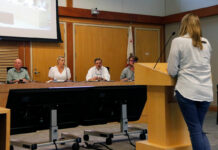The news this week is good. Sonoma County was just rated the eighth healthiest county in California, based on findings in a national survey of 3,000 counties. Good health is always good news.
Good health is what we value most as individuals and families. Our grandmothers always told us, “If you haven’t got your health, then you haven’t got anything.” Besides less pain and more enjoyment, good health means smaller doctor bills, less sick days without pay and fewer burdens on our loved ones.
The same holds true for whole communities and counties. Even better, healthy communities pay less taxes or otherwise avoid the costly complications of unhealthy outcomes like poor education, homelessness, crowded jails and lack of basic healthcare.
Sonoma County was rated high for such things as life expectancy, healthy foods, low violent crimes, clean drinking water, access to community health clinics, low teen birth rates and a generally active lifestyle.
The County of Sonoma launched its Health Action Initiative in 2007 to become the healthiest county in California by year 2020. Health Action’s plan included iWORKwell, iGROW, iWALK and Cradle to Career programs. The county won a $3.5 million federal Community Transformation Grant and they have engaged almost 200 local non-government groups and individual leaders to join the cause.
As a doctor might say, “All vital signs look great.” Our county’s prognosis is very positive and our future looks both healthy and bright.
But, as any discerning doctor or mindful grandmother would add, keeping healthy is a daily chore.
Sonoma County’s youth still experiment or use too much alcohol and drugs. Almost one-third (32 percent) of children under age 13 report recent use of drugs or alcohol. Teen use of marijuana is especially alarming. The county’s healthy 2020 index calls for reducing these levels to 10 percent or lower.
The high school graduation rate in the county is 83.4 percent, close to the 2020 goal of 90 percent. But third grade reading proficiency scores are just 43 percent, with a goal of 80 percent of all students.
Healthy communities, like healthy families, invest in their children. Good beginnings, childcare services, healthy foods and safe environments lead to more high school graduations, higher education achievement, career development and less crime, lower drug use, more self-esteem and reduced jail time.
Sonoma County right now is struggling to provide enough childcare programs for working families. The lack of affordable housing is now a well-documented crisis with no solution in sight. There is still a gang problem in many neighborhoods and we see daily evidence of hunger, homelessness and economic inequality on too many street corners and food lines.
But we also see encouraging signs of community mobilization under the county’s Health Action initiative and a series of “upstream investments.” These include healthy baby and wellness programs, safe routes to school, farm-to-family connections, open space and park opportunities, expanded mental health services and support for the elderly.
These investments require tax dollars. But that does not mean raising taxes; it means better use of the taxes we already pay. Staying healthy is always cheaper than getting sick. Paying for a high school education or junior college tuition is a fraction of what we pay to send someone to jail or a drug rehabilitation program.
As the eighth healthiest county in California, we want to continue to improve our ranking and our overall quality of life. By 2020, based on our progress so far, there is no reason Sonoma County cannot become California’s healthiest community.
But let’s remember how we want to be measured. We want to be like a healthy family, where all the members are healthy and doing well, and not just some of us. All our children’s health, education and well-being should come first, always. Whatever we do second will then be healthier, too.
— Rollie Atkinson








